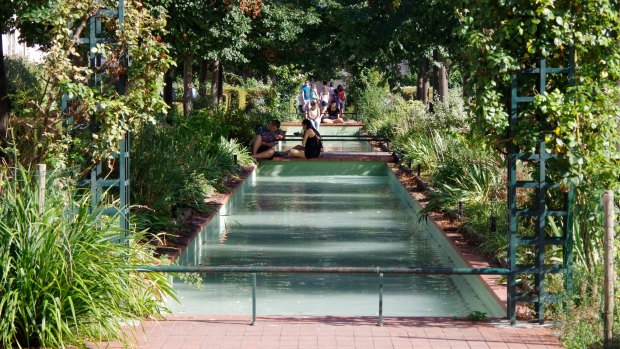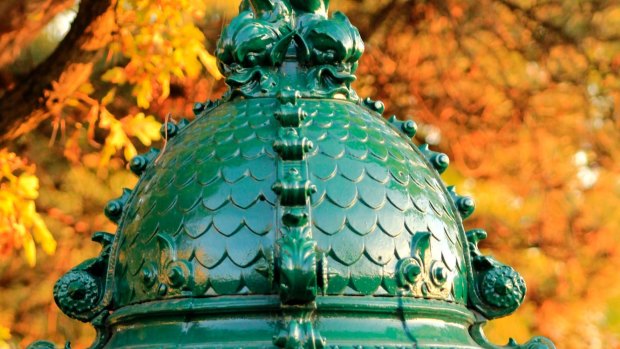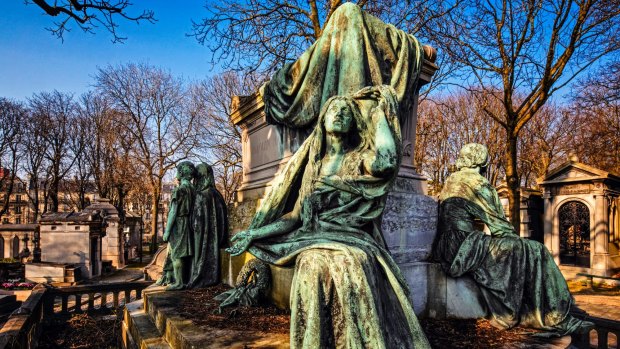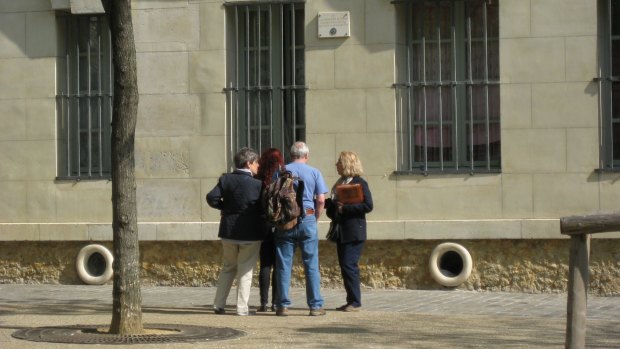This was published 7 years ago
Paris Greeters free guided walking tours: How to experience Paris from the inside

Coulee Verte linear park runs for almost five kilometres along a former railway line.Credit: Alamy
On a brisk morning, with the autumnal leaves a palette of red, yellow and brown, the Place de la Nation presents a picture-perfect Parisian scene.
The sun shines brightly on sculptures of the kings Louis IX and Philip II standing astride two towering columns as commuters emerge from the Paris Metro.
Nearby, a bustling street market is doing an energetic trade in delicacies such as tripe, ox tongue and horse meat.

One of Paris' 'Wallace fountans' in autumn.Credit: iStock
The only clue to the bloodbath visited upon this quiet corner of Paris is a small plaque on the wall of the 18th-century Customs house built to tax goods brought from outside the city walls.
It marks the site of a guillotine built in 1794, two years after the square was renamed Place du Trone-Renverse – Square of the Toppled Throne – at the height of the French Revolution.
The vast plaza was formerly known as Place du Trone for the throne built in 1660 to celebrate the arrival of the Sun King Louis XIV to Maria Theresa of Spain following their wedding in southern France.

The tomb of Joachim Maria de Errazu, Pere Lachaise Cemetery, Paris.Credit: Bruno De Hogues
But respect for royalty had long gone by the time of "the terror".
More than 1300 people were killed in just six weeks, says Christiane Mazzi, a volunteer guide with the Paris Greeters. "They were beheaded because they didn't share the revolutionary ideals."
The executioners killed indiscriminately, including a group of Carmelite nuns who sang hymns as they were led to the guillotine.

Christiane Mazzi, right, a volunteer guide with the Paris Greeters.
"You could find dressmakers, a priest, a clerk and noble families," Mazzi says. "The bodies were thrown at night into two mass graves just behind those buildings over there."
The graves later became part of the Cimetiere de Picpus, Paris's largest private cemetery. It also houses the tomb of the Marquis de Lafayette, an aristocratic military officer who fought in the French Revolution and American Revolutionary War.
As we walk, it is easy to forget that behind this Paris' elegant façade lies a bloody, violent past. But Mazzi's vivid descriptions bring to life characters and events that otherwise seem as real as the plot from Game of Thrones.
Yet she is not a historian or even a paid guide, but a member of Paris Greeters, a global network of volunteers who offer visitors free walking tours of their neighbourhoods.
The Global Greeter Network covers more than 100 destinations around the world, including major cities in France and other European countries as well as North America, Russia, India, Israel and Australia.
The guides I have met in France and Australia have been retired, passionate about their hometowns and eager to share personal stories and memories.
Mazzi, who worked for IBM, is no exception, reminiscing about her youth, pointing out favourite cafes and restaurants and regaling us with the area's rich history.
She is aware of visitors' boredom threshold, potential jetlag, poor choice of clothing for the Paris chill and other travel commitments.
"Feel comfortable with me," Mazzi says. "If you are tired, if you are fed up, I'm quite open-minded. I know you are on 'oliday."
Strolling away from the carnage of the French Revolution, Mazzi leads us towards 19th-century Paris when medieval neighbourhoods, often crowded and unsanitary, were swept away and to bring light and air into the city.
The Paris of Georges-Eugene Haussmann, with its wide boulevards, parks and squares, is a different world, as Mazzi points out, from the city Voltaire described with its markets "showing off their filthiness, spreading infection and causing continuing disorders."
Voltaire would find little cause to complain about the outdoor market along the Cours de Vincennes, which trades on Wednesday and Saturday mornings.
The nearby Daumesnil street market – open on Tuesday and Friday – is reputedly Paris' longest, running more than 1.3 kilometres.
But the Cours de Vincennes has plenty of stalls to satisfy the hungry tourists, especially its triperie selling tongue, heart, brains and body parts and chevaline stocked with horse meat saucisson, steak and other equine morsels.
As we stroll through the market, Mazzi shares her favourite recipes for preparing ox tongue – mouth-watering with parsley and thyme – and duck leg ("oh, it's delicious").
Veering away from the market, we stroll through the streets of Picpus in the 12th arrondissement lined with endless boulangeries, fromageries, bistros and bars.
Maybe the French fondness for revolution is really about keeping one's weight in check?
Mazzi also introduces us to four charming ladies, whose kindness, simplicity, charity and sobriety have become symbols of the city. They form part of the Wallace Fountains, cast-iron sculptures that serve as public drinking fountains scattered throughout the city.
"This Mr Wallace was an Englishman," Mazzi says. "He wanted to help people in need so he paid for all these fountains in Paris."
The illegitimate son of an aristocrat, Sir Richard Wallace is buried nearby in the Pere Lachaise Cemetery, one of the most visited cemeteries in the world and which is also the final resting place of Oscar Wilde, Jim Morrison, Moliere and Maria Callas.
Our final destination is less morbid – the Coulee Verte linear park that runs for almost five kilometres along a former railway line.
Opened in 1993, the park runs from the Opera Bastille to the peripherique highway that circles Paris and was the forerunner to Sydney's Goods Line and New York's High Line.
A riot of flowers in the spring, the park is filled with dappled light and trees shedding their autumnal leaves as winter approaches.
The park is as peaceful as a church, and treated with a similar respect by locals.
As a jogger passes us, Mazzi points to a red sign that puts the fleet of foot in their place. "La pratique du jogging est toleree dans la mesure ou elle ne gene pas les promeneurs."
Joggers are tolerated … barely.
TRIP NOTES
STAY
The four-star boutique Hotel Moliere (21, rue Moliere 75001 Paris) is located in the heart of Paris, close to the Palais-Royal, the Tuileries gardens and Louvre. The rooms are elegant and its English-speaking staff friendly and helpful. Rates start from €160 for a standard room. See hotel-moliere.fr.
TOUR
Paris Greeters do not offer specific tours, but invite visitors to register their interest in a guided walk. Once registered, visitors will be allocated a guide and encouraged to make direct contact with them. Groups are limited to six people and visitors with limited mobility are welcome. See greeters.paris
Andrew Taylor travelled with assistance from the National Gallery of Australia.
Sign up for the Traveller Deals newsletter
Get exclusive travel deals delivered straight to your inbox. Sign up now.